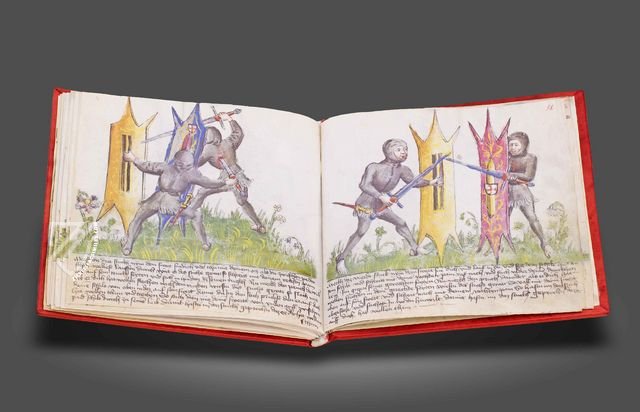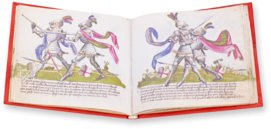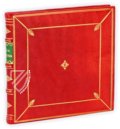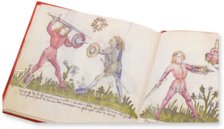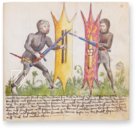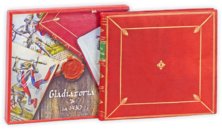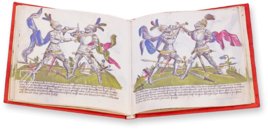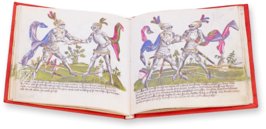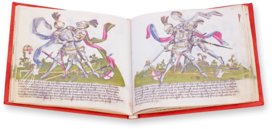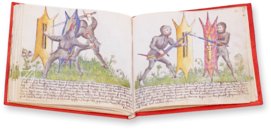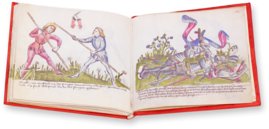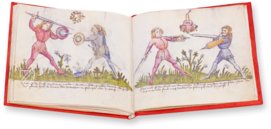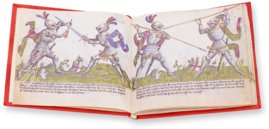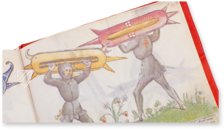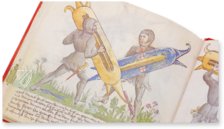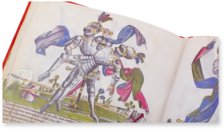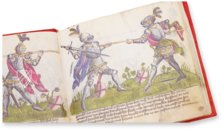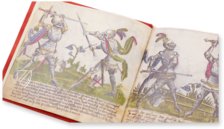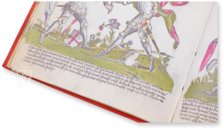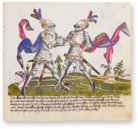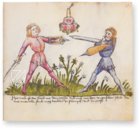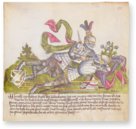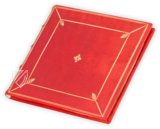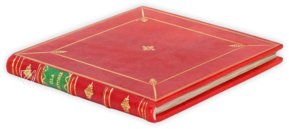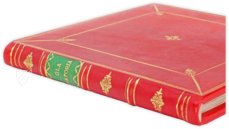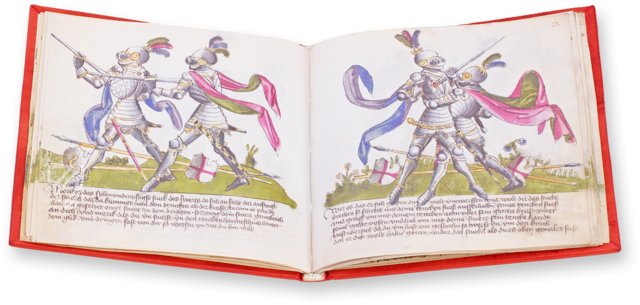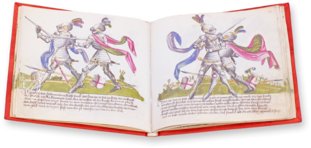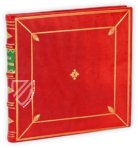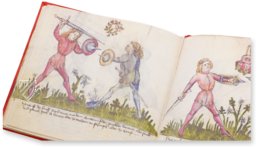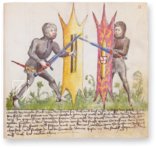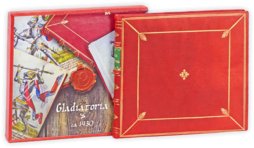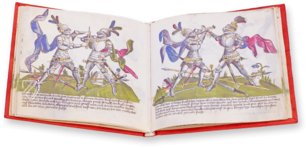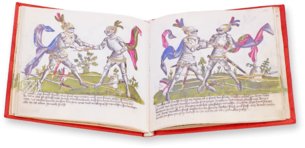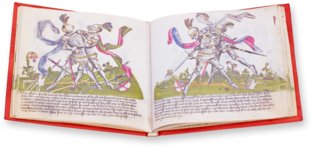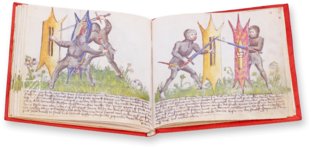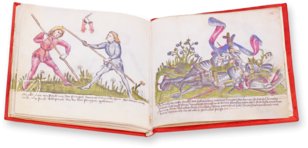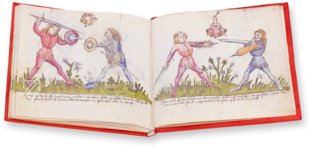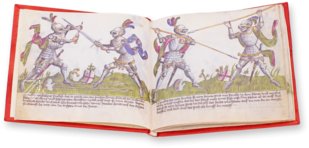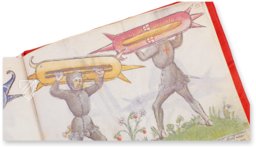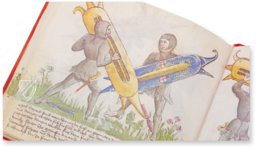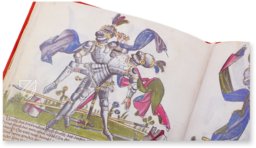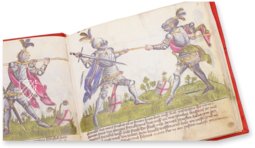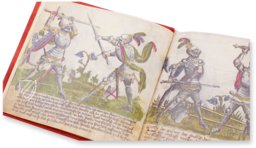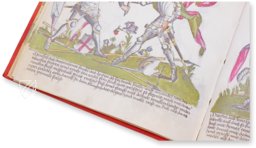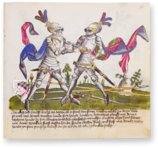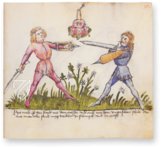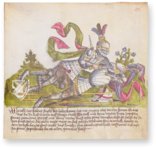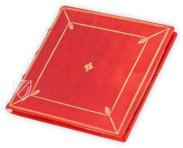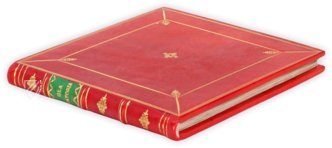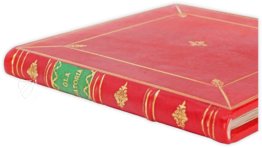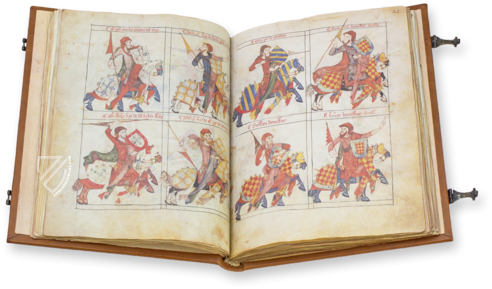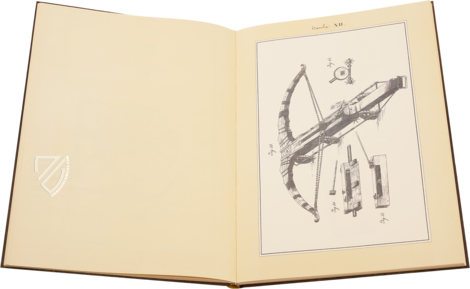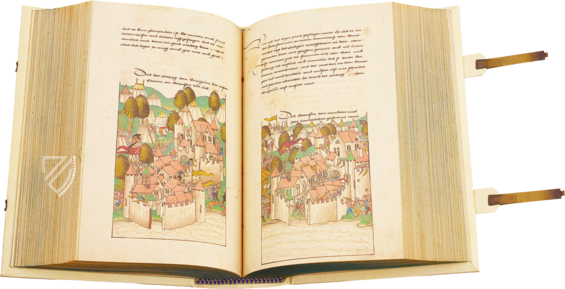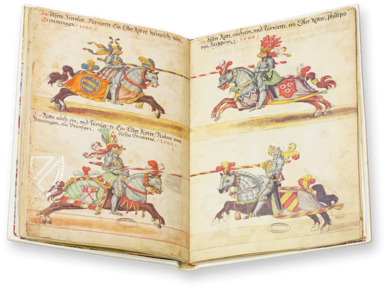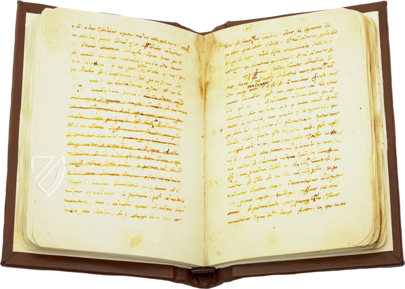Gladiatoria
(1,000€ - 3,000€)
The socially prestigious sport of fencing has existed in Europe since around the 13th century and spread across the whole continent through the 16th century. From the late 13th century onwards, organized fencing schools, fencing societies, and fencing masters gained more and more significance as they taught and practised their fighting techniques throughout the Holy Roman Empire. In the German-speaking area, the art of fencing was founded by Johannes Liechtenauer. Based on his teachings, the so-called Gladiatoria were written, a series of publications that dealt in detail with Liechtenauer's fencing techniques, illustrating and concisely explaining them in dynamic illuminations. The work is considered the most important source on the medieval sport of fencing. Probably the most beautiful copy of the Gladiatoria with 116 almost full-page illuminations is kept today under the shelfmark Ms. Germ. Quart. 16 in the Krakow Biblioteka Jagiellońska.
Gladiatoria
Today, the Middle Ages are considered to be a dreary epoch of history. The plague, witch burning, brutal religious wars – for many people, all of these mark the epoch of the Middle Ages. It is often forgotten that many of today’s most highly-regarded activities have their origins in the Middle Ages. For example, fencing is directly connected with this historical period. This historic martial art with swords, which has been popular across Europe since the 13th century, is seen today as a prestigious sport. The rules thereof go back to fencing books that explained the martial art with the help of artful depictions. The Gladiatoria are a series of fencing books originating from the early 15th century and are illustrated in an exceptionally beautiful manner. They are considered to be the most important historical source concerning the great discipline of fencing.
The German Art of Fencing
The series Gladiatoria is comprised of six editions and was composed ca. 1430 in Early High German. Who exactly is responsible for the production of the work has not been verified to this day. The library of Jagiellonen University in Krakow, Poland, one of the oldest universities in Poland, has what is arguably the most beautiful edition of the fencing manuscripts. The illustrated depictions show fencing techniques as taught by Johannes Liechtenauer, a 14th century German fencing master.
The School of Johannes Liechtenauer
Johannes Liechtenauer is a central figure in the history of European sword fighting. Precious little information exists about the fencing master’s life. Liechtenauer, who was probably born in Middle Franconia, has been designated today as the founding father of the “German school” of fencing. This is a sport discipline comprised of fighting techniques with various edged weapons such as the dagger, dusack, and longsword as well as unarmed fighting techniques such as those based on wrestling. In the fencing book at hand, the techniques depicted are clearly influenced by the Liechtenauer School, it is possible that the text was even personally made by one of the master’s students.
Enchanting Illumination
Like the other editions of the Gladiatoria, this fencing book contains illustrations on almost every page. The depictions were accompanied by short explanations of the respectively pictured techniques. The hand-painted, colorful pictures show knights in armor of diverse designs fighting with various weapons. Realistic battle scenes playout here against vivid landscapes such as blooming fields under a light-blue sky. The gifted miniaturist who made the images furnished his scenes with banners of different colors, elaborate decoration of the armor, and shields flaunting escutcheons. The exciting, artful pictures also offer therewith a special charm for the reader who is not familiar with fencing.
Codicology
- Alternative Titles
- Fechtbuch
- Size / Format
- 118 pages / 20.8 × 19.8 cm
- Origin
- Germany
- Date
- Ca. 1430
- Epochs
- Style
- Language
- Script
- Littera bastarda
- Illustrations
- Each parchment leaf of Gladiatoria features a drawing presenting a combat technique (save for the first and last)
- Content
- 116 large-format miniatures
- Artist / School
- Manual on 166 different fighting techniques in the tradition of Johannes Liechtenauer's school, each illustrated by an illumination with a detailed caption
Gladiatoria
Ground Fighting
Although rarely portrayed in artistic depictions of medieval warfare wherein everyone stands valiantly with swords in hand, Liechtenauer identified grappling and wrestling as fundamental skills for warriors learning the art of fencing. The two combatants shown here are covered with plate armor from head to toe. Their shields, spears, and longswords are discarded on the ground beside them. One has climbed on top of the other and goes for the kill by stabbing his dagger through his enemy’s visor.
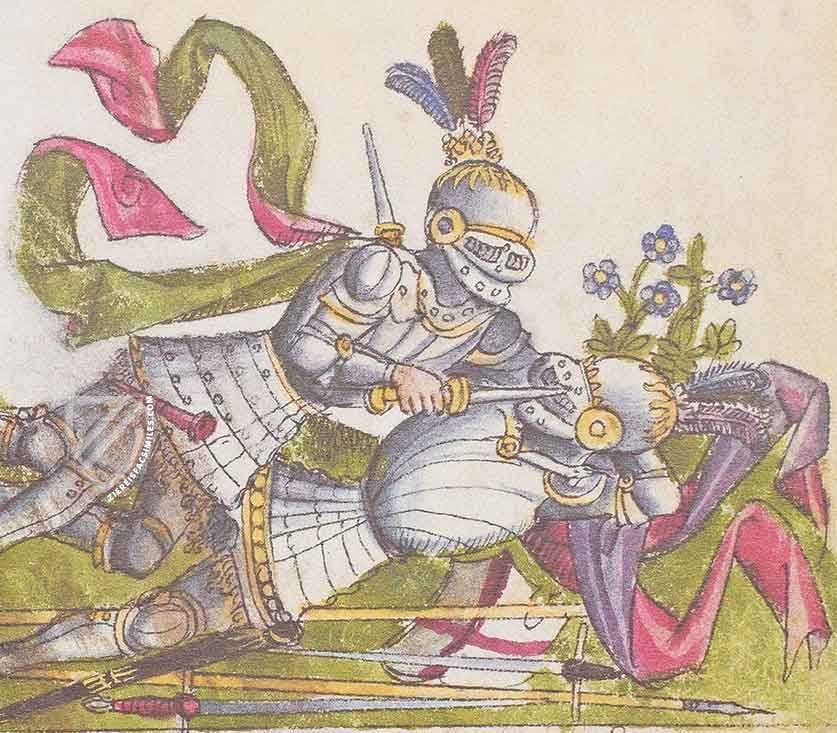
Gladitoria
Battle on Foot in Full Armor with Dagger
This is a scene from the third series on combat techniques, which gives practical instructions on what to do when your primary weapons, in this case a spear and sword, are unavailable. Two men-at-arms in full plate armor with chain mail underneath grapple with one another and are embellished with flowing robes and gold leaf. Their discarded long arms and shields lay on the grass behind them.
The combatant on the right has drawn his dagger first. Rather than drawing his own dagger, his opponent has seized his forearm, twisted it, and is guiding the dagger away from him. At the same time, the combatant on the left has positioned his front foot behind his opponent’s, perhaps preparing to trip him and thrown him on the ground.
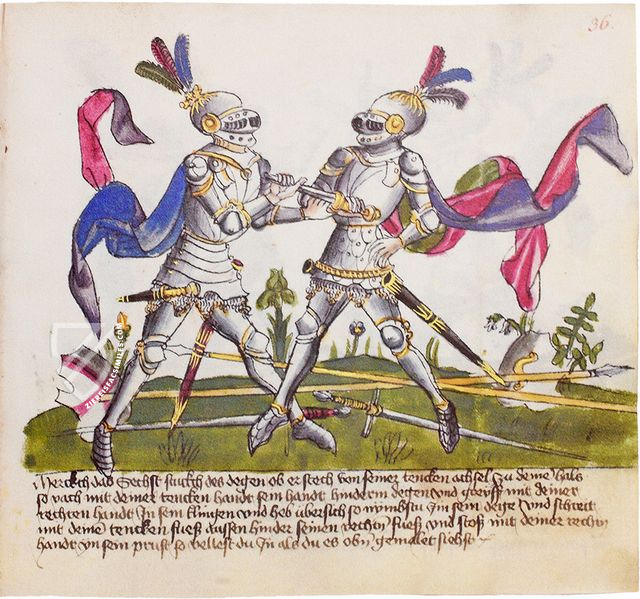
#1 Gladiatoria
Language: English
(1,000€ - 3,000€)
- Treatises / Secular Books
- Apocalypses / Beatus
- Astronomy / Astrology
- Bestiaries
- Bibles / Gospels
- Chronicles / History / Law
- Geography / Maps
- Saints' Lives
- Islam / Oriental
- Judaism / Hebrew
- Single Leaf Collections
- Leonardo da Vinci
- Literature / Poetry
- Liturgical Manuscripts
- Medicine / Botany / Alchemy
- Music
- Mythology / Prophecies
- Psalters
- Other Religious Books
- Games / Hunting
- Private Devotion Books
- Other Genres
- Afghanistan
- Armenia
- Austria
- Belgium
- Belize
- Bosnia and Herzegovina
- China
- Colombia
- Costa Rica
- Croatia
- Cyprus
- Czech Republic
- Denmark
- Egypt
- El Salvador
- Ethiopia
- France
- Germany
- Greece
- Guatemala
- Honduras
- Hungary
- India
- Iran
- Iraq
- Israel
- Italy
- Japan
- Jordan
- Kazakhstan
- Kyrgyzstan
- Lebanon
- Liechtenstein
- Luxembourg
- Mexico
- Morocco
- Netherlands
- Palestine
- Panama
- Peru
- Poland
- Portugal
- Romania
- Russia
- Serbia
- Spain
- Sri Lanka
- Sweden
- Switzerland
- Syria
- Tajikistan
- Turkey
- Turkmenistan
- Ukraine
- United Kingdom
- United States
- Uzbekistan
- Vatican City
- A. Oosthoek, van Holkema & Warendorf
- Aboca Museum
- Ajuntament de Valencia
- Akademie Verlag
- Akademische Druck- u. Verlagsanstalt (ADEVA)
- Aldo Ausilio Editore - Bottega d’Erasmo
- Alecto Historical Editions
- Alkuin Verlag
- Almqvist & Wiksell
- Amilcare Pizzi
- Andreas & Andreas Verlagsbuchhandlung
- Archa 90
- Archiv Verlag
- Archivi Edizioni
- Arnold Verlag
- ARS
- Ars Magna
- ArtCodex
- AyN Ediciones
- Azimuth Editions
- Badenia Verlag
- Bärenreiter-Verlag
- Belser Verlag
- Belser Verlag / WK Wertkontor
- Benziger Verlag
- Bernardinum Wydawnictwo
- BiblioGemma
- Biblioteca Apostolica Vaticana (Vaticanstadt, Vaticanstadt)
- Bibliotheca Palatina Faksimile Verlag
- Bibliotheca Rara
- Boydell & Brewer
- Bramante Edizioni
- Bredius Genootschap
- Brepols Publishers
- British Library
- C. Weckesser
- Caixa Catalunya
- Canesi
- CAPSA, Ars Scriptoria
- Caratzas Brothers, Publishers
- Carus Verlag
- Casamassima Libri
- Centrum Cartographie Verlag GmbH
- Chavane Verlag
- Christian Brandstätter Verlag
- Circulo Cientifico
- Club Bibliófilo Versol
- Club du Livre
- CM Editores
- Collegium Graphicum
- Collezione Apocrifa Da Vinci
- Comissão Nacional para as Comemorações dos Descobrimentos Portugueses
- Coron Verlag
- Corvina
- CTHS
- D. S. Brewer
- Damon
- De Agostini/UTET
- De Nederlandsche Boekhandel
- De Schutter
- Deuschle & Stemmle
- Deutscher Verlag für Kunstwissenschaft
- DIAMM
- Droz
- E. Schreiber Graphische Kunstanstalten
- Ediciones Boreal
- Ediciones Grial
- Ediclube
- Edições Inapa
- Edilan
- Editalia
- Edition Deuschle
- Edition Georg Popp
- Edition Leipzig
- Edition Libri Illustri
- Editiones Reales Sitios S. L.
- Éditions de l'Oiseau Lyre
- Editions Medicina Rara
- Editorial Casariego
- Editorial Mintzoa
- Editrice Antenore
- Editrice Velar
- Edizioni Edison
- Egeria, S.L.
- Eikon Editores
- Electa
- Emery Walker Limited
- Enciclopèdia Catalana
- Eos-Verlag
- Ephesus Publishing
- Ernst Battenberg
- Eugrammia Press
- Extraordinary Editions
- Fackelverlag
- Facsimila Art & Edition
- Facsimile Editions Ltd.
- Facsimilia Art & Edition Ebert KG
- Faksimile Verlag
- Feuermann Verlag
- Folger Shakespeare Library
- Franco Cosimo Panini Editore
- Friedrich Wittig Verlag
- Fundación Hullera Vasco-Leonesa
- G. Braziller
- Gabriele Mazzotta Editore
- Gebr. Mann Verlag
- Gesellschaft für graphische Industrie
- Getty Research Institute
- Giovanni Domenico de Rossi
- Giunti Editore
- Graffiti
- Grafica European Center of Fine Arts
- Guido Pressler
- Guillermo Blazquez
- Gustav Kiepenheuer
- H. N. Abrams
- Harrassowitz
- Harvard University Press
- Helikon
- Hendrickson Publishers
- Henning Oppermann
- Herder Verlag
- Hes & De Graaf Publishers
- Hoepli
- Holbein-Verlag
- Houghton Library
- Hugo Schmidt Verlag
- Idion Verlag
- Il Bulino, edizioni d'arte
- ILte
- Imago
- Insel Verlag
- Insel-Verlag Anton Kippenberger
- Instituto de Estudios Altoaragoneses
- Instituto Nacional de Antropología e Historia
- Introligatornia Budnik Jerzy
- Istituto dell'Enciclopedia Italiana - Treccani
- Istituto Ellenico di Studi Bizantini e Postbizantini
- Istituto Geografico De Agostini
- Istituto Poligrafico e Zecca dello Stato
- Italarte Art Establishments
- Jan Thorbecke Verlag
- Johnson Reprint Corporation
- Josef Stocker
- Josef Stocker-Schmid
- Jugoslavija
- Karl W. Hiersemann
- Kasper Straube
- Kaydeda Ediciones
- Kindler Verlag / Coron Verlag
- Kodansha International Ltd.
- Konrad Kölbl Verlag
- Kurt Wolff Verlag
- La Liberia dello Stato
- La Linea Editrice
- La Meta Editore
- Lambert Schneider
- Landeskreditbank Baden-Württemberg
- Leo S. Olschki
- Les Incunables
- Liber Artis
- Library of Congress
- Libreria Musicale Italiana
- Lichtdruck
- Lito Immagine Editore
- Lumen Artis
- Lund Humphries
- M. Moleiro Editor
- Maison des Sciences de l'homme et de la société de Poitiers
- Manuscriptum
- Martinus Nijhoff
- Maruzen-Yushodo Co. Ltd.
- MASA
- Massada Publishers
- McGraw-Hill
- Metropolitan Museum of Art
- Militos
- Millennium Liber
- Müller & Schindler
- Nahar - Stavit
- Nahar and Steimatzky
- National Library of Wales
- Neri Pozza
- Nova Charta
- Oceanum Verlag
- Odeon
- Orbis Mediaevalis
- Orbis Pictus
- Österreichische Staatsdruckerei
- Oxford University Press
- Pageant Books
- Parzellers Buchverlag
- Patrimonio Ediciones
- Pattloch Verlag
- PIAF
- Pieper Verlag
- Plon-Nourrit et cie
- Poligrafiche Bolis
- Presses Universitaires de Strasbourg
- Prestel Verlag
- Princeton University Press
- Prisma Verlag
- Priuli & Verlucca, editori
- Pro Sport Verlag
- Propyläen Verlag
- Pytheas Books
- Quaternio Verlag Luzern
- Reales Sitios
- Recht-Verlag
- Reichert Verlag
- Reichsdruckerei
- Reprint Verlag
- Riehn & Reusch
- Roberto Vattori Editore
- Rosenkilde and Bagger
- Roxburghe Club
- Salerno Editrice
- Saltellus Press
- Sandoz
- Sarajevo Svjetlost
- Schöck ArtPrint Kft.
- Schulsinger Brothers
- Scolar Press
- Scrinium
- Scripta Maneant
- Scriptorium
- Shazar
- Siloé, arte y bibliofilia
- SISMEL - Edizioni del Galluzzo
- Sociedad Mexicana de Antropología
- Société des Bibliophiles & Iconophiles de Belgique
- Soncin Publishing
- Sorli Ediciones
- Stainer and Bell
- Studer
- Styria Verlag
- Sumptibus Pragopress
- Szegedi Tudomànyegyetem
- Taberna Libraria
- Tarshish Books
- Taschen
- Tempus Libri
- Testimonio Compañía Editorial
- Thames and Hudson
- The Clear Vue Publishing Partnership Limited
- The Facsimile Codex
- The Folio Society
- The Marquess of Normanby
- The Richard III and Yorkist History Trust
- Tip.Le.Co
- TouchArt
- TREC Publishing House
- TRI Publishing Co.
- Trident Editore
- Tuliba Collection
- Typis Regiae Officinae Polygraphicae
- Union Verlag Berlin
- Universidad de Granada
- University of California Press
- University of Chicago Press
- Urs Graf
- Vallecchi
- Van Wijnen
- VCH, Acta Humaniora
- VDI Verlag
- VEB Deutscher Verlag für Musik
- Verlag Anton Pustet / Andreas Verlag
- Verlag Bibliophile Drucke Josef Stocker
- Verlag der Münchner Drucke
- Verlag für Regionalgeschichte
- Verlag Styria
- Vicent Garcia Editores
- W. Turnowski Ltd.
- W. Turnowsky
- Waanders Printers
- Wiener Mechitharisten-Congregation (Wien, Österreich)
- Wissenschaftliche Buchgesellschaft
- Wissenschaftliche Verlagsgesellschaft
- Wydawnictwo Dolnoslaskie
- Xuntanza Editorial
- Zakład Narodowy
- Zollikofer AG

